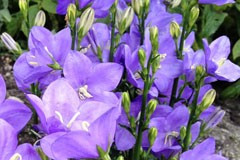- Out-of-Stock



Rarely offered miniature for the rock garden with mounding habit. Porcelain blue bells on wiry upright stems, astounding flowers for such a dwarf plant. Will also grow well in the cottage garden or a pot if given occasional lime.
Rarely offered miniature for the rock garden with mounding habit. Porcelain blue bells on wiry upright stems, astounding flowers for such a dwarf plant. Will also grow well in the cottage garden or a pot if given occasional lime.
Data sheet
Campanula punctata type with semi double flowers, tall panicles, elegant and lovely. Spreading habit, frost and drought hardy.
New variety from our trial beds, a lovely pink form which is an offspring from Achillea 'Love Parade', demonstates all the rubustness of other achillea varieties. Once established best not overly fertilized to maintain upright habit, as with other varieties.
Long flowering flame orange wallflower, bird and butterfly attracting, especially during the winter months. Trim annually like with penstemons and lavender.
A good multiplier with a understated greenish bronze colour, nice and subtle.
White flowers with a blush of orange on the outer edge. Beautiful and unusual. Autumn stock pre sold but we will have more ready after July.
Tall perennial suitable for clay soil types, winter deciduous and frost resistant. Light blue flowers in summer on tall stems, clumping and easy.
Itoh type paeonia resulting from crossing herbaceous and shrubby species, beautiful foliage and huge ruffled soft lemon flowers like a old fashioned rose. Need good drainage and fertile soil, long lived plant.
Grey blue low growing grass with weeping foliage, used for landscaping applications in mass plantings, edgings, or combined with euphobias, westringia and sedums.
Strong landscaping variety with bushy growth ideal for mass planting or hedges. Blue flowers in summer and drought tolerant once established.
Cushion-forming plant from Chile for the rockgarden or trough. Great around stones, spreads horizontally to form a tight mat.
A softer apricot colour than the regular brighter tangerine variety, flowers for much of the year in fertile heavier soil types.
Lovely white form of the normally purple species.This campanula doesn"t like too much winter wet or shade.
Botanical rarity seldom seen in Australian gardens, native to Chile. Bright magenta poppy-like flowers on long graceful stems that move beautifully in a light breeze. Mid-green diamond shaped leaves form a good mound of evergreen foliagel, which works well as a focal point in succulent groupings and rock garden plantings. Best in drier drained soils,...
The lush green leaves resemble the foliage of a Hosta and look great in mass plantings beneath trees. New Zealand native with sprays of starry white flowers in summer.
Paprika red yarrow, fades to attractive dusky red as flowers age. Easy drought and frost hardy perennial, medium height.
Old fashioned double primrose for part sun or shade in good soil. We never have many of these regretfully

Rarely offered miniature for the rock garden with mounding habit. Porcelain blue bells on wiry upright stems, astounding flowers for such a dwarf plant. Will also grow well in the cottage garden or a pot if given occasional lime.